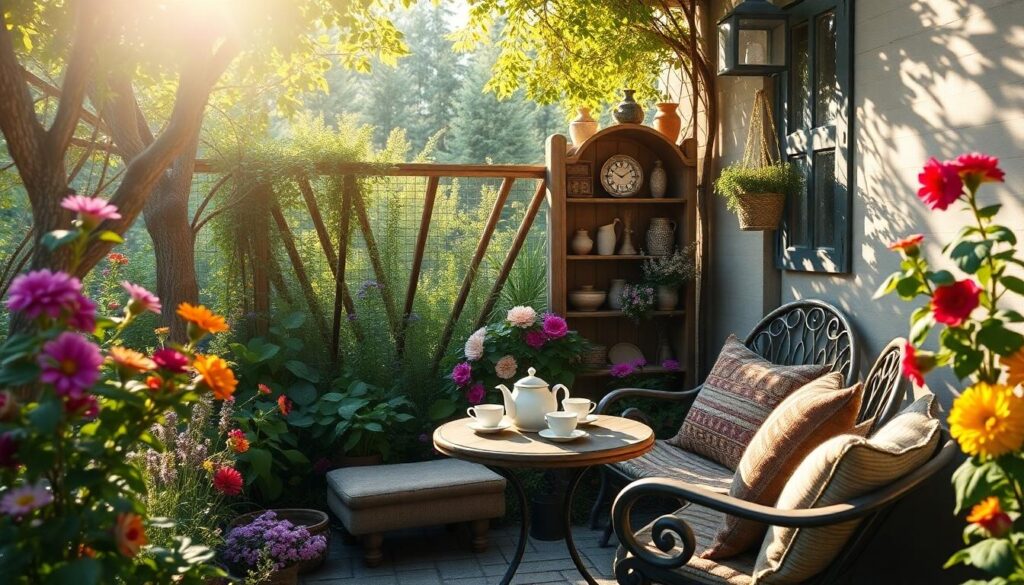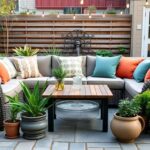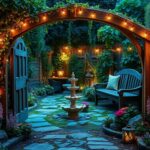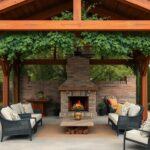Looking to transform that unused corner of your backyard into something special? Garden nooks aren’t just beautiful additions to any outdoor space—they’re personal retreats that invite relaxation and reflection right at home. We’ve gathered the most inspiring backyard garden nook ideas that combine comfort, style, and functionality.
Creating your own garden sanctuary doesn’t require enormous space or a professional landscaper. With some creativity and basic materials, you’ll be amazed at how a small corner can become your favorite spot to unwind. From cozy reading corners surrounded by climbing roses to meditation spaces nestled among tall grasses, we’ll show you how to maximize even the tiniest backyard areas for maximum enjoyment.
10 Cozy Garden Nook Ideas to Transform Your Backyard
1. Reading Retreat Under a Tree
Create a literary haven beneath the shady canopy of your favorite backyard tree. Position a comfortable weatherproof chair or hammock alongside a small side table for your books and beverages. Adding outdoor pillows and a throw blanket makes this space instantly inviting for hours of uninterrupted reading. Portable bookshelves or weatherproof storage boxes keep your reading materials organized and protected from sudden weather changes.
2. Meditation Corner with Zen Elements
Transform a quiet corner into a meditation sanctuary using simple zen principles. Install a smooth stone pathway leading to a comfortable seating cushion or low bench. Surround this area with potted plants like lavender or jasmine that release calming scents. Water features such as small fountains or a tiny pond add soothing sounds that enhance your meditation practice. Stone lanterns or solar lights create ambient illumination for evening reflection sessions.
3. Tea Garden with Vintage Charm
Design a charming tea garden using vintage furniture pieces like an antique wrought iron table and chairs. Plant herbs commonly used in teas—mint, lemon balm, and chamomile—within easy reach of your seating area. Hanging vintage teacups filled with trailing plants adds whimsical visual interest. A trolley cart stocked with tea essentials makes serving convenient while improving the garden’s aesthetic appeal.
4. Artist’s Corner with Natural Inspiration
Set up an outdoor studio where creativity flows freely amidst natural beauty. Position an easel facing your garden’s most picturesque view, with a comfortable stool and a weatherproof storage chest for art supplies. Hanging mason jars from nearby branches provides convenient brush storage. Solar-powered string lights extend your creative sessions into evening hours, casting a warm glow over your workspace.
5. Fire Pit Gathering Space
Build a cozy conversation area centered around a fire pit for year-round enjoyment. Arrange weather-resistant seating in a circle, using Adirondack chairs or built-in benches topped with outdoor cushions. Potted plants with varied heights create visual interest and a sense of enclosure. Storage ottomans serve dual purposes as extra seating and places to keep blankets and fire tools neatly tucked away.
6. Hidden Hammock Haven
Create a secluded hammock retreat screened by tall ornamental grasses or climbing plants. Secure your hammock between trees or install posts specifically for this purpose. Surrounding the area with container gardens filled with fragrant flowers enhances the sensory experience. A small side table provides space for refreshments, while string lights woven through nearby foliage create magical evening ambiance.
7. Outdoor Movie Nook
Design a backyard cinema experience using a blank wall or hanging sheet as your screen. Arrange floor cushions, outdoor bean bags, or a daybed for comfortable viewing. Potted plants around the perimeter define the space while providing privacy. A rolling cart holds your projector and speakers, making setup easy. Mason jar lanterns lining the pathway guide viewers safely to and from the house after dark.
8. Children’s Secret Garden
Create a magical hideaway that sparks young imaginations using natural materials. Create living walls with sunflowers or climbing beans growing on simple structures. A child-sized table and chairs become perfect spots for outdoor crafts and snacks. Whimsical touches like painted stepping stones, fairy doors attached to trees, or wind chimes engage multiple senses and encourage outdoor play.
9. Yoga Deck with Morning Sun
Build a dedicated yoga platform positioned to catch gentle morning sunlight. Use weather-resistant decking materials that feel comfortable underfoot. Plant lavender or lemongrass nearby for natural aromatherapy during your practice. Wall-mounted hooks hold yoga mats and props, while a small covered cabinet protects bluetooth speakers from the elements. Solar-powered lanterns illuminate early morning or evening sessions.
10. Couples’ Conversation Nook
Design an intimate seating area perfect for meaningful conversations and connection. Position a loveseat or two comfortable chairs facing each other rather than outward toward the garden. A small fire table or candle centerpiece creates ambiance while providing gentle warmth on cooler evenings. Plant tall ornamental grasses or install lattice panels with climbing roses to create privacy from neighbors. String lights overhead complete the romantic atmosphere for starlit conversations.
1. Creating a Reading Retreat Under Shade Trees

Transform a quiet corner of your backyard into a peaceful reading sanctuary by utilizing the natural canopy of shade trees. This perfect escape combines nature’s beauty with functional design elements to create your own literary oasis.
Selecting Weather-Resistant Furniture for Comfort
When designing your reading retreat, durability and comfort should be your top priorities. Teak, cedar, and powder-coated metal furniture offer excellent resistance to outdoor elements while maintaining aesthetic appeal. Adirondack chairs provide classic comfort with their wide armrests perfect for balancing books or drinks. Weatherproof benches with stained-wood finishes resist moisture damage and blend beautifully with natural surroundings. Add plush outdoor pillows with UV-resistant fabric to prevent fading and enhance comfort during long reading sessions. Portable options like lightweight folding chairs or a hammock allow flexibility in your garden nook setup. Position your seating to face the most appealing garden views, creating a backdrop that enhances your reading experience.
Incorporating Bookshelves and Storage Answers
Smart storage answers keep your reading retreat organized and functional throughout the seasons. Wall-mounted weatherproof shelves installed near your seating area provide easy access to your favorite outdoor reads. Decorative baskets offer stylish containment for magazines, novels, and gardening journals while adding rustic charm. Waterproof storage benches serve dual purposes by providing both seating and space to store blankets, gardening tools, and reading accessories. Vintage crates repurposed as shelving add character to smaller nooks while maximizing vertical space. Hanging organizers mounted under pergolas keep reading materials elevated and protected from ground moisture. Surrounding your storage elements with flowering plants like yellow sedum creates visual interest and reinforces the natural garden aesthetic while ensuring clear pathways bordered by deep plantings maintain privacy in your literary sanctuary.
2. Designing a Meditation Corner with Zen Elements
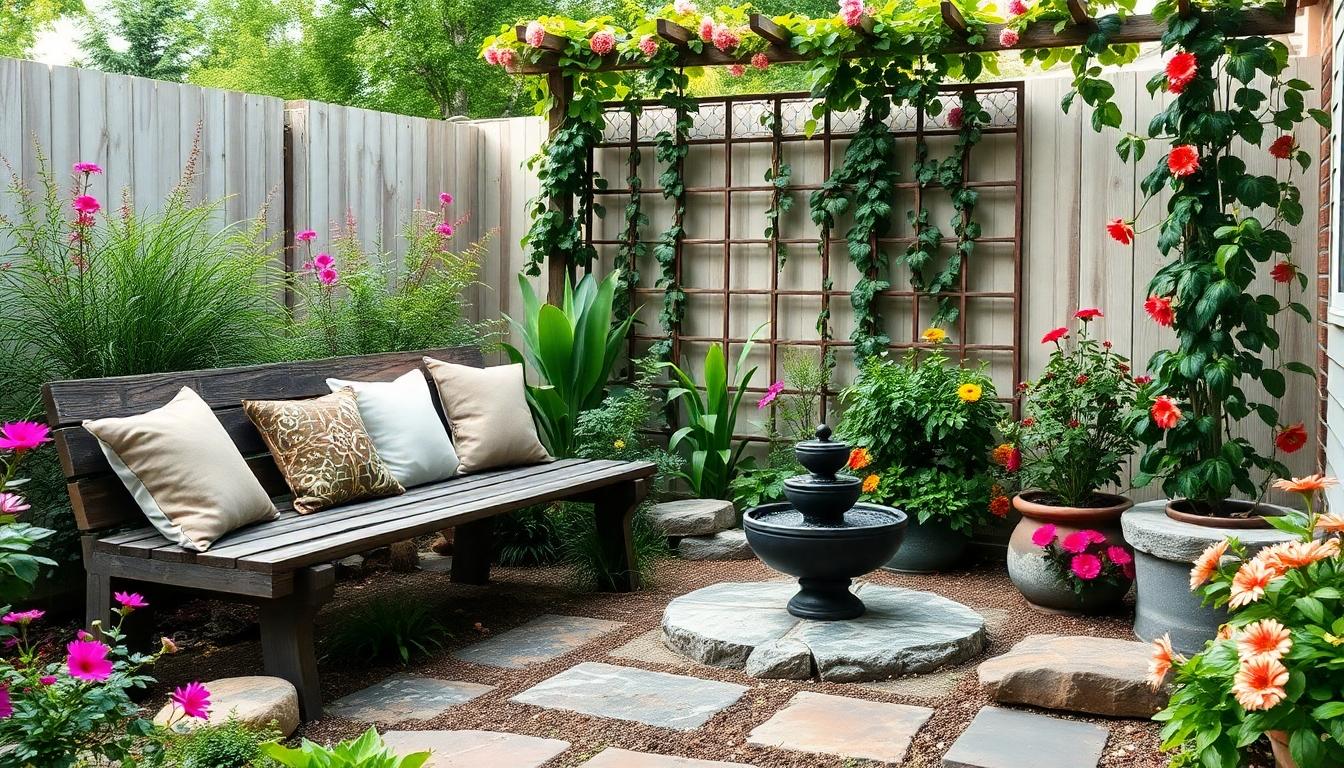
Creating a secluded meditation space in your backyard can transform an unused corner into a personal sanctuary for relaxation and mindfulness. The key is to combine simplicity with natural elements that engage the senses while maintaining a peaceful atmosphere.
Creating a Secluded Seating Area
Rustic benches and Adirondack chairs offer comfortable perches for meditation when placed under trees or arbors for natural shade. Position your seating away from high-traffic areas of your yard to minimize distractions and maximize tranquility. Low-profile options like floor cushions or stone stools maintain the minimalist aesthetic essential to zen design principles. Natural materials such as wood, bamboo, or straw mats help evoke a sense of calm and connection to nature. Privacy can be enhanced by surrounding your meditation corner with dense foliage or flowering plants like sedum, creating a natural barrier between your sanctuary and the rest of the industry.
Installing a Small Water Feature for Tranquility
Tabletop fountains provide the perfect water element for smaller meditation corners, creating gentle sounds that mask ambient noise. Recirculating basin features serve as focal points while requiring minimal maintenance and water usage. Miniature ponds can host aquatic plants for additional visual interest while contributing to the overall serenity of your space. Placement near seating areas amplifies the relaxing effect of flowing water, helping to create an immersive meditative environment. Surrounding your water feature with smooth stones or pebbles enhances the minimalist aesthetic while providing practical drainage and visual continuity.
Choosing Calming Plants and Stones
Fragrant, low-maintenance plants like lavender and jasmine engage your sense of smell, improving the meditative experience. Hostas offer lush foliage with minimal care requirements, creating a verdant backdrop for contemplation. Mosses and ornamental grasses introduce varied textures that catch light and movement, adding subtle dynamism to your zen corner. River rocks, slate slabs, and fine gravel can be arranged to define pathways or borders within your meditation space. Rounded stones clustered in strategic locations create organic flow and serve as visual anchors for meditation focus. Non-slip surfaces are essential near seating areas to ensure safety and peace of mind while you relax.
For optimal privacy, we recommend installing trellises with climbing vines such as wisteria or ivy to enclose your meditation area naturally. Shade sails or retractable covers provide protection from harsh sunlight during summer months, extending the usability of your space throughout different seasons. Remember to keep all design elements proportional to your available space—compact features work beautifully in corners or under existing structures without creating visual clutter.
3. Building a Rustic Tea Garden Hideaway

Creating a rustic tea garden hideaway offers a charming retreat where you can enjoy your favorite brew surrounded by nature’s beauty. This specialized garden nook combines functional design with whimsical elements to create a space that feels both secluded and inviting.
Selecting the Perfect Tea Garden Plants
When designing your tea garden hideaway, choosing the right plants creates the foundation for your rustic sanctuary. Fragrant herbs like lavender, rosemary, and chamomile not only provide delightful aromas but also offer healing properties that enhance your tea-drinking experience. These versatile plants can be harvested for homemade tea blends, creating a truly authentic garden-to-cup experience. Beautiful flowering plants such as roses, peonies, and hydrangeas add romantic visual elements and classic garden charm to your hideaway. For structure and defined spaces, incorporate boxwood or topiary shrubs to create natural borders that separate your tea nook from the rest of your garden. Selecting plants suited to your local climate ensures your garden remains vibrant throughout the seasons with minimal maintenance.
Crafting DIY Seating with Natural Materials
Natural materials form the heart of a truly rustic tea garden hideaway, providing comfortable seating that blends seamlessly with the surroundings. Rustic wooden benches crafted from reclaimed or untreated wood offer durable seating options while adding authentic charm and character to your space. Vine-covered structures using wicker, rattan, or a simple trellis create romantic seating areas when adorned with climbing plants like wisteria or ivy, which provide natural shade and privacy. Stone or brick seating incorporates permanent elements into your garden design, offering weather-resistant options that develop character and patina over time. These natural seating arrangements can be enhanced with weather-resistant cushions and throws for comfort without sacrificing the rustic aesthetic.
Building a Rustic Tea Garden Hideaway
Finding the perfect location starts with selecting a secluded spot in your garden, ideally under the dappled shade of a mature tree or beneath an existing arbor. This natural canopy creates the ideal environment for enjoying tea in comfort, even on warmer days. Soft lighting transforms your tea garden into an enchanting evening retreat, with options like vintage lanterns, mason jar lights, or delicate string lights draped through surrounding branches. Garden elements like repurposed teapots, vintage china displayed on weathered shelves, and winding pathways made from natural stone or brick tie the theme together. These pathways not only guide visitors through your garden but also define the space and add to the overall rustic appeal. The combination of thoughtful planting, natural seating, and charming decorative touches creates a hideaway that invites lingering conversations over steaming cups of tea.
4. Establishing a Romantic Dinner Nook with Twinkling Lights
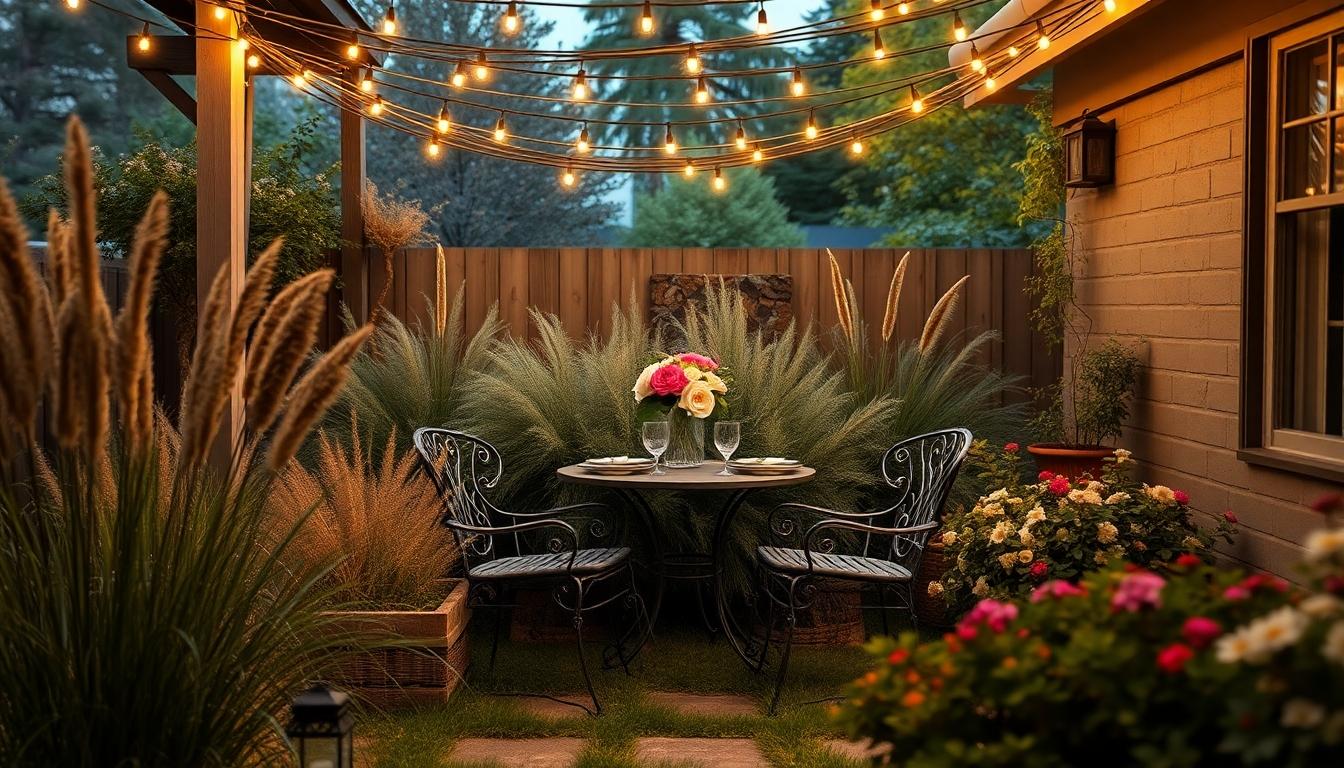
Transform an ordinary corner of your backyard into a magical dining spot perfect for date nights under the stars. Creating this intimate space combines thoughtful lighting with strategic planting to establish privacy and ambiance.
Setting Up Ambient Lighting for Evening Enjoyment
String lights draped overhead create an enchanting canopy that instantly transforms your outdoor dining space into a romantic retreat. Fairy lights woven through tree branches or hung from garden structures provide a magical twinkling effect that softens the atmosphere. Candlelight adds a warm, intimate glow to your dining experience – place lanterns or pillar candles in hurricane holders to protect flames from wind. Solar-powered path lights offer a practical lighting solution that illuminates walkways while adding charm without increasing your energy bills. These lights automatically activate at dusk, ensuring your dinner nook remains beautifully lit throughout your evening gatherings.
Creating Privacy with Strategic Plantings
Tall ornamental grasses and flowering shrubs establish natural boundaries that shield your romantic nook from neighboring views. Arbors and trellises covered with climbing vines such as wisteria or clematis create living walls that envelop your dining space in greenery and fragrance. Compact hedges like boxwood define the perimeter of your nook while providing year-round structure and privacy. These strategic plantings not only create seclusion but also enhance the romantic atmosphere with their textures and seasonal blooms.
Additional Ideas for a Romantic Garden Nook
A bistro table with comfortable chairs offers the perfect setting for intimate dinners, while weather-resistant cushions and throws add comfort and style. Elegant outdoor linens in rich colors elevate your dining experience and create a restaurant-worthy setting right in your backyard. Fresh flower arrangements placed at the center of your table introduce natural fragrance and beauty that complement the surrounding garden. These thoughtful details transform a simple outdoor meal into a memorable romantic experience that you’ll want to enjoy again and again.
5. Constructing a Morning Coffee Patio in a Sunny Corner
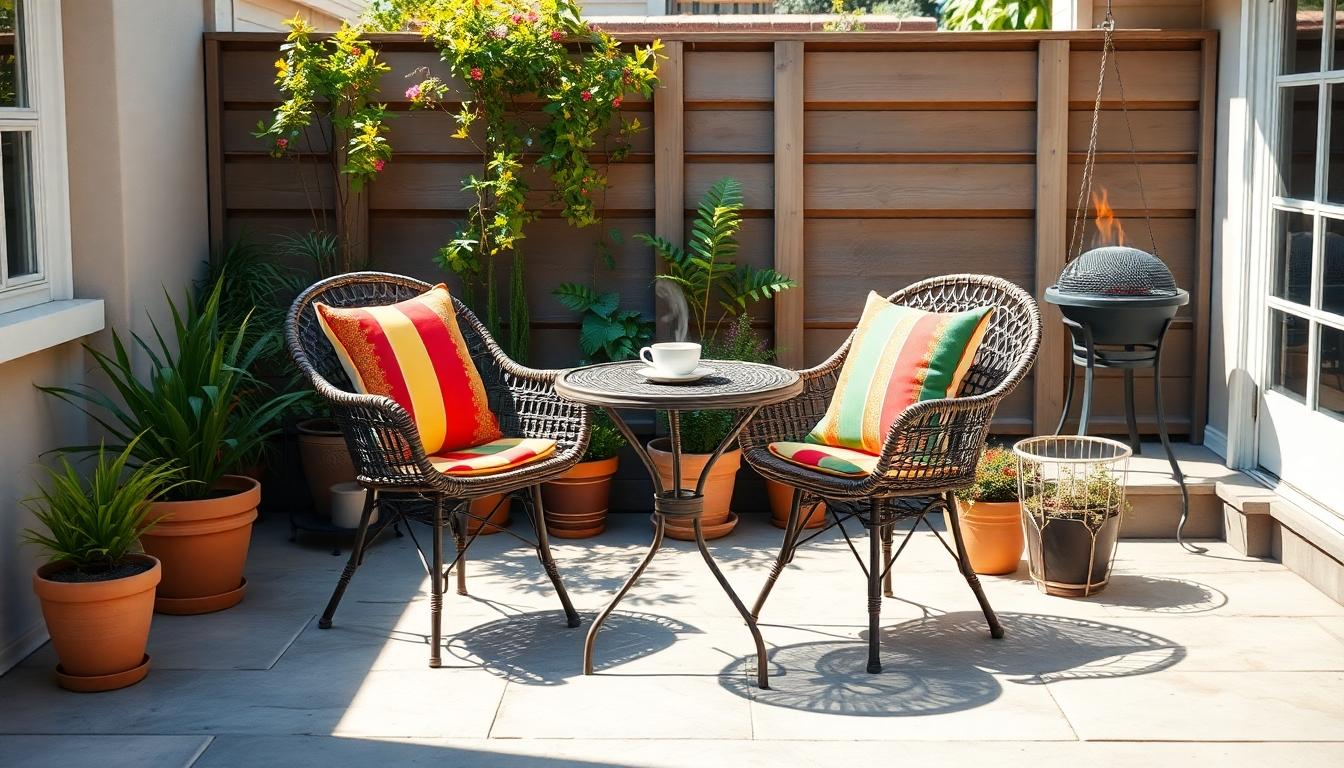
Starting your day with coffee outdoors can become a cherished ritual when you have the perfect spot designed for morning enjoyment. A dedicated coffee patio in a sunny corner transforms an ordinary backyard space into a delightful retreat for those early hours.
Positioning for Optimal Sunrise Views
Finding the right position for your morning coffee patio is crucial for maximizing those golden sunrise moments. Select a corner of your yard that receives early morning sunlight to create the perfect ambiance for your coffee ritual. East-facing locations naturally capture the first rays of sunshine, providing warmth during cooler mornings while avoiding the harsh midday heat. Strategic placement near flowering plants can enhance your experience with natural fragrance as you sip your brew. Consider the seasonal sun patterns in your area to ensure your patio remains functional throughout most of the year. For those with limited space, even a small nook against a fence or wall can be transformed into a sunrise-catching retreat with thoughtful positioning.
Accessorizing with Weather-Resistant Decor
Durability meets style when you select the right weather-resistant furnishings for your coffee patio. Wicker and metal furniture pieces offer both resilience and aesthetic appeal, standing up to morning dew and occasional rainfall. Outdoor fabrics specifically designed to withstand elements provide comfort without sacrificing longevity – look for cushions and pillows made with water-resistant materials. A small bistro table paired with comfortable chairs creates the perfect setting for casual morning conversations or peaceful solitude with your favorite mug. Adding a portable fire pit brings warmth during cooler seasons, extending the usability of your coffee nook throughout the year. Water features such as small fountains introduce soothing sounds that enhance the tranquil morning atmosphere while masking any neighborhood noise. Consider incorporating potted plants that can be rearranged as needed to create privacy or follow optimal sunlight patterns as seasons change.
6. Transforming a Corner into a Backyard Art Studio
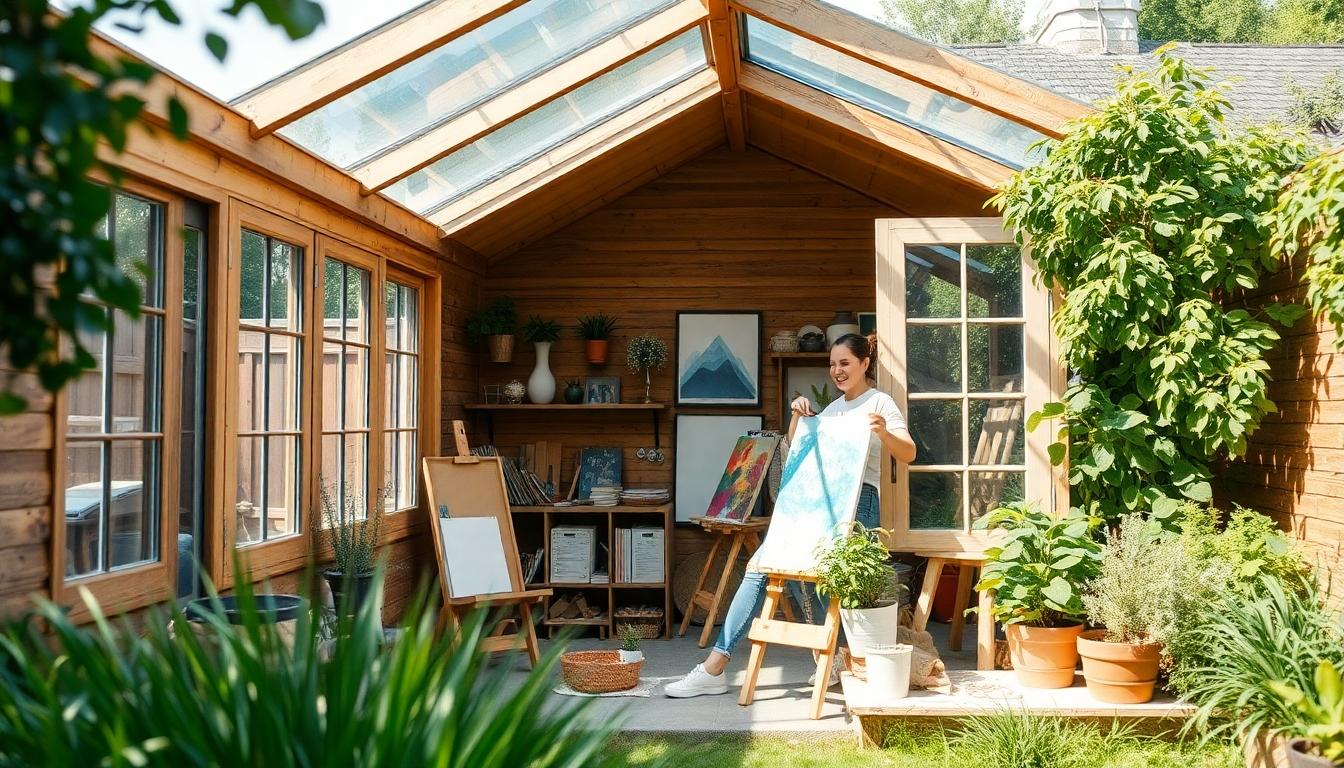
That forgotten corner of your backyard can become a functional and inspiring art studio with some thoughtful planning. Repurposing underused spaces allows you to create a dedicated area for your creative pursuits without the need for major renovations or expansions.
Weather-Proofing Your Creative Space
Durability should be your top priority when building an outdoor art studio that can withstand various weather conditions. Cedar and pressure-treated wood offer excellent resistance to moisture, making them ideal materials for the structure’s frame and exterior. Protective elements like pergolas, retractable awnings, and overhangs provide essential shelter from unexpected rain showers while allowing you to work comfortably outdoors during pleasant weather. Proper insulation and ventilation systems are crucial for maintaining year-round comfort in your creative space, preventing temperature fluctuations that could damage art supplies or finished pieces. We recommend installing weather stripping around doors and windows to prevent drafts and moisture infiltration that could compromise your artistic environment.
Maximizing Natural Light for Artistic Pursuits
Position your backyard art studio facing north whenever possible to capture consistent, indirect lighting that artists prefer for accurate color perception and detail work. Large windows, strategically placed skylights, and glass doors will flood your creative space with abundant natural light, reducing your dependence on artificial lighting during daylight hours. Surrounding your studio with thoughtfully placed trees or tall ornamental grasses helps diffuse harsh sunlight while maintaining visual harmony with the rest of your garden industry. Glass panels or translucent roofing materials can further enhance the natural illumination within your workspace without creating distracting glare or shadows. Consider incorporating movable or adjustable window treatments that allow you to control light levels throughout the day as the sun changes position, ensuring optimal lighting conditions for various artistic techniques and mediums.
7. Installing a Hammock Haven Between Trees or Posts
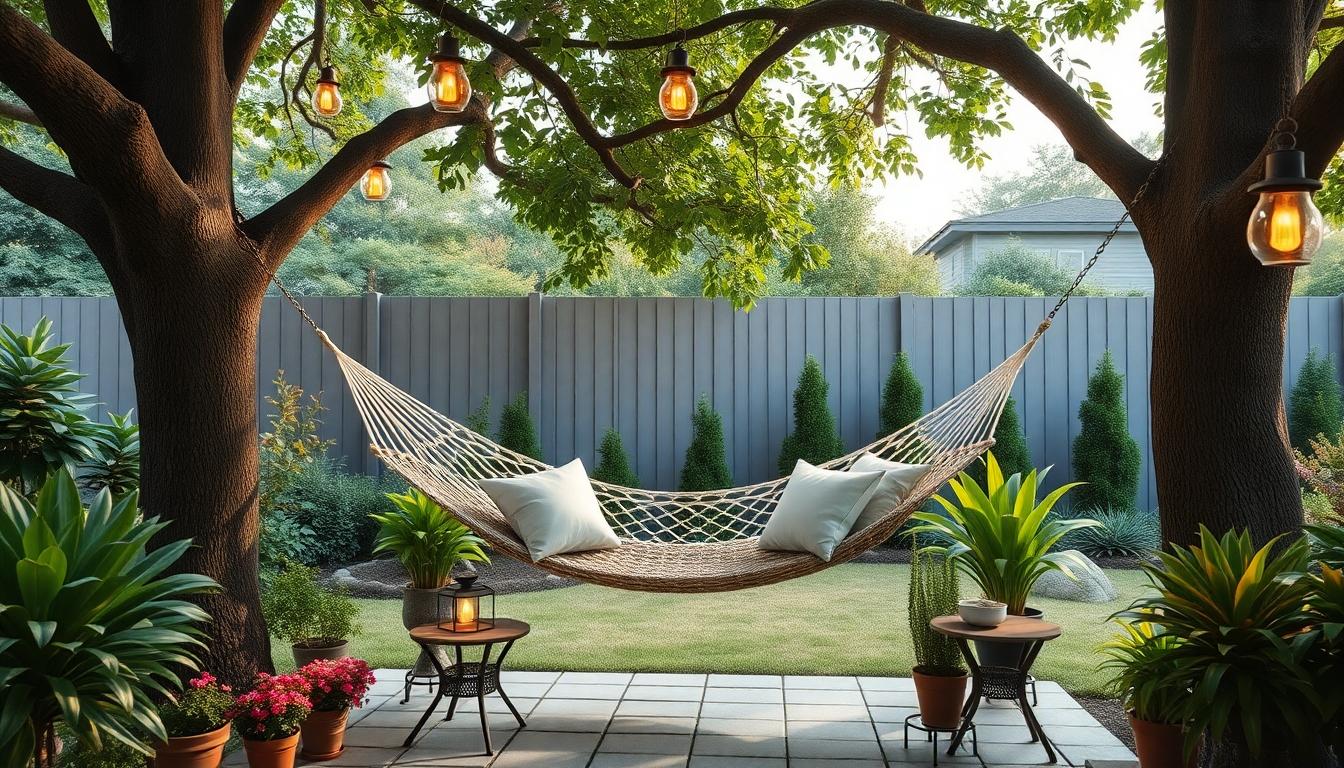
Creating a peaceful hammock retreat in your backyard is one of the most rewarding garden nook projects. Suspending a hammock between trees or sturdy posts instantly transforms an unused area into a relaxing haven perfect for afternoon naps, reading, or simply enjoying nature.
Selecting Support Structures for Different Yard Types
The first step in establishing your hammock haven involves choosing appropriate support structures based on your yard’s layout. Mature trees positioned 12-15 feet apart provide ideal natural anchors for hammocks, offering both stability and aesthetic appeal. Yards without suitable trees can benefit from installing sturdy wooden posts or metal hammock stands specifically designed to support weight safely. Cedar and pressure-treated pine posts work exceptionally well for permanent installations, as they resist rot and weathering over time. For properties with unusual layouts, consider custom-built pergola structures that serve the dual purpose of hammock support and creating a defined garden space with added privacy.
Adding Side Tables and Comfort Accessories
Transform your basic hammock setup into a luxurious retreat by incorporating thoughtful accessories that enhance both comfort and functionality. Small weatherproof side tables positioned within arm’s reach provide convenient surfaces for books, beverages, or electronic devices. Plush outdoor pillows and water-resistant blankets add important comfort while creating a visually appealing nook that invites relaxation. Solar-powered lanterns hung from nearby branches create magical ambient lighting for evening enjoyment without requiring electrical outlets. Potted plants placed strategically around your hammock haven add natural beauty while increasing privacy, with flowering varieties like jasmine or lavender introducing pleasant fragrances to your resting space. Weather-resistant storage containers cleverly disguised as garden stools offer practical answers for keeping accessories protected when not in use.
8. Creating a Child-Friendly Secret Garden Nook
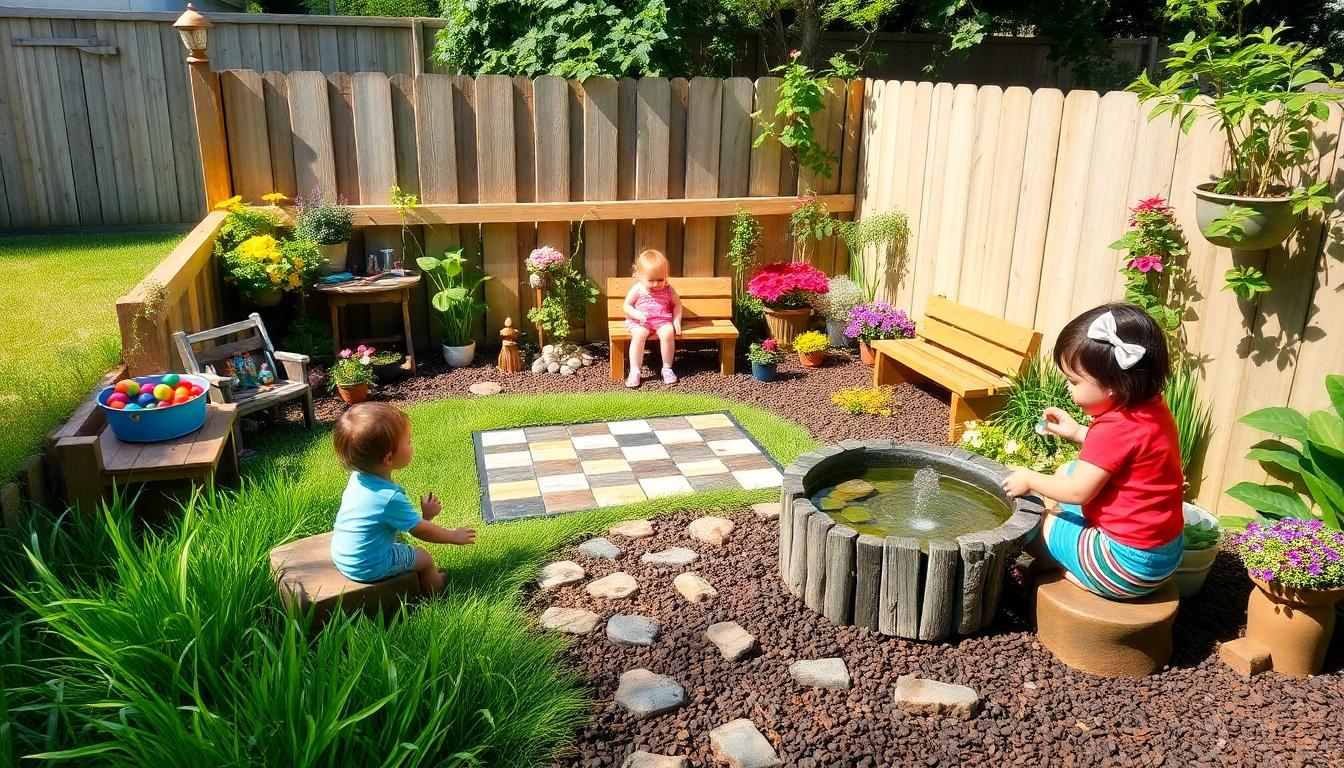
Transforming a corner of your backyard into a magical retreat for children combines imagination with outdoor play. These special spaces encourage creativity while fostering a love of nature in young ones.
Incorporating Whimsical Elements and Fairy Gardens
Fairy gardens serve as the perfect centerpiece for any child-friendly nook, complete with miniature figurines, tiny furniture, and kid-friendly plants like thyme or clover. We recommend using natural materials such as twigs and small stones to create charming pathways and diminutive houses that spark imagination. Secret paths, hidden benches, and decorative stepping stones create an adventure-filled environment that encourages exploration and discovery. Adding a checkerboard made from natural materials like stone or wood transforms the space into an outdoor game area where children can spend hours playing. Small DIY fountains introduce soothing water sounds that enhance the peaceful ambiance while adding another sensory element to the garden experience.
Ensuring Safety While Maintaining Magic
Soft landscaping materials like mulch or grass provide necessary cushioning to minimize injury risks during active play. All structures within the garden nook, including benches and dens, must be stable and securely constructed to prevent accidents while children explore. Clear, easily navigable paths allow children to move safely throughout the garden space without trampling plants or risking trips and falls. Adult supervision remains essential when children use these garden spaces, balancing freedom of exploration with necessary oversight for safety. By combining whimsical design elements with thoughtful safety considerations, you’ll create an enchanting outdoor space that delights children while giving parents peace of mind.
9. Designing a Vertical Garden Nook for Small Spaces
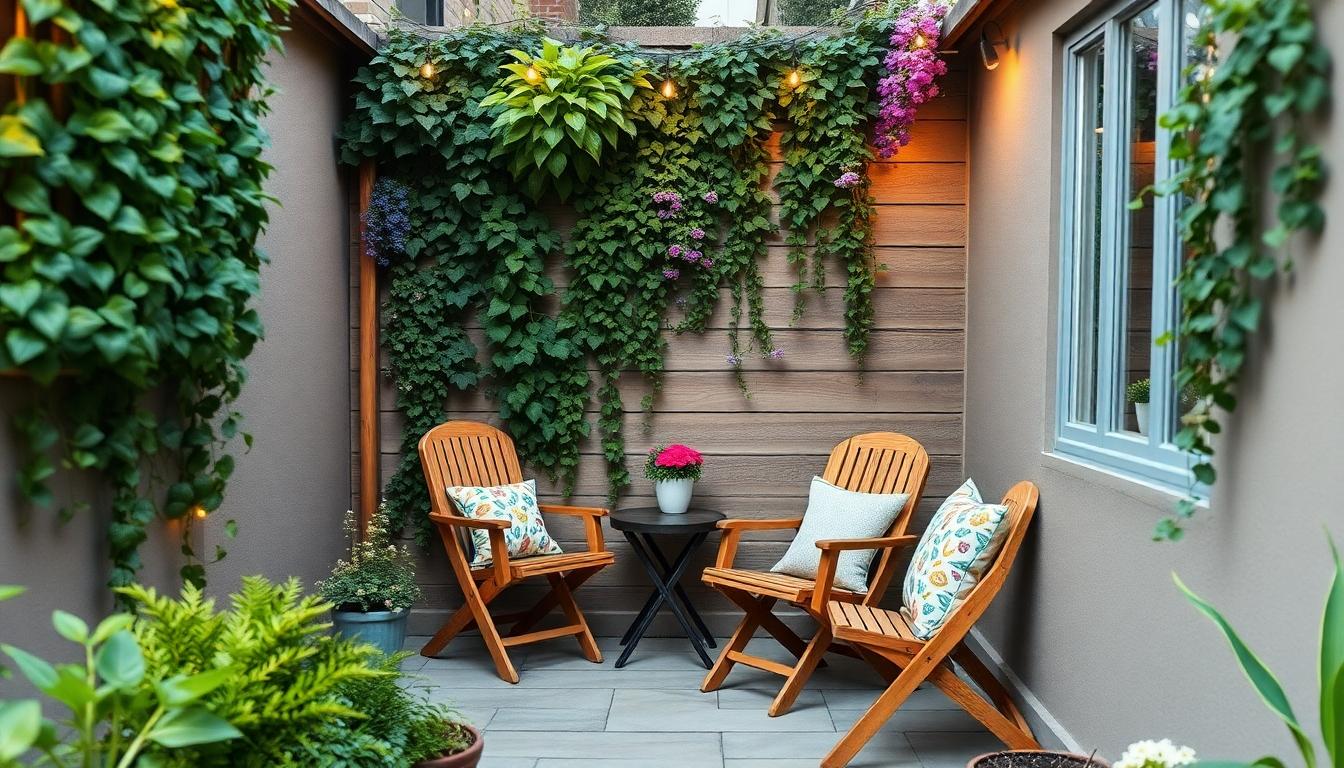
Limited backyard space doesn’t mean you have to compromise on creating a lush garden retreat. Vertical gardening offers an innovative solution to maximize small areas while still enjoying the benefits of greenery and relaxation.
Choosing the Right Plants for Wall Gardens
Climbing plants serve as the backbone of successful vertical gardens, with varieties like ivy, clematis, and wisteria growing upward naturally on trellises or walls. These plants maximize your limited space by expanding vertically rather than horizontally, creating dramatic green backdrops without consuming precious floor area. Succulents and herbs make excellent additions to wall gardens due to their compact size and minimal maintenance requirements. Their shallow root systems adapt perfectly to vertical planting configurations, allowing you to create diverse, textured arrangements that thrive in small spaces. Consider mixing different plant varieties to create visual interest through contrasting colors, textures, and growing patterns.
Integrating Seating Within Limited Square Footage
Foldable furniture offers the perfect solution for small garden nooks, providing versatility and space-saving capabilities. Tables and chairs that can be collapsed when not in use allow your vertical garden space to transform based on your needs, accommodating solo relaxation or small gatherings. Compact seating options like benches or small hammocks can be strategically tucked into corners or positioned between vertical garden structures, creating cozy retreats without overwhelming the limited area. Adding soft cushions and throws to your seating choices transforms simple furniture into inviting relaxation spots, improving comfort without taking up additional square footage.
Vertical shelving systems installed against walls or fences can simultaneously serve as plant displays and functional surfaces for drinks or books. String lights or hanging lanterns add warmth and ambiance to your vertical garden nook without occupying valuable ground space, creating a magical atmosphere for evening enjoyment. Through thoughtful design that prioritizes upward growth and multi-functional elements, even the smallest outdoor spaces can become enchanting garden retreats.
10. Setting Up a Bird-Watching Corner with Natural Appeal
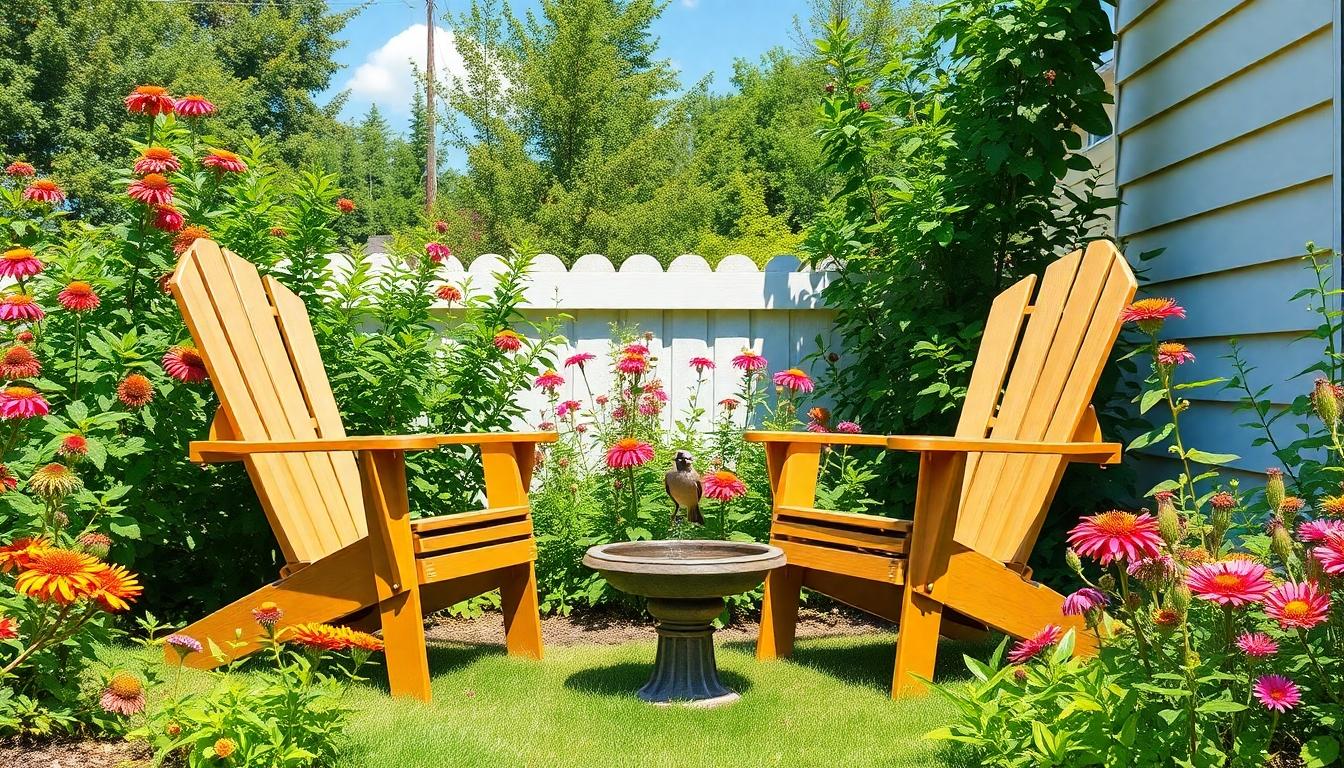
Transform a quiet corner of your backyard into a captivating bird-watching nook where you can connect with nature and enjoy the therapeutic benefits of observing local wildlife.
Attracting Local Wildlife with Native Plants
Native plants serve as powerful magnets for local birds, providing essential food sources and natural habitats. Choose indigenous flowering species like coneflowers, black-eyed Susans, and cardinal flowers that produce seeds birds naturally seek out. Berry-producing shrubs such as serviceberry, dogwood, and elderberry offer vital nutrition throughout different seasons. Create layers of vegetation by incorporating native grasses, shrubs, and trees to provide diverse habitats that attract various bird species. Water features like small bird baths or shallow ponds will complement your plantings by providing drinking and bathing spots that birds can’t resist. Remember to avoid chemical pesticides, as these harm the insects many birds rely on for food.
Positioning Comfortable Seating for Optimal Viewing
Strategic seating placement transforms casual bird observation into an immersive experience. Position your bench or chair with your back to the sun to prevent glare and improve visibility of birds visiting your native plantings. Weatherproof Adirondack chairs offer both comfort and durability for extended viewing sessions. Consider installing a small pergola or gazebo that provides shade while maintaining clear sightlines to feeders and bird-friendly plants. Portable seating options give you flexibility to relocate based on seasonal bird activity patterns. Add a small side table for keeping field guides, binoculars, and refreshments within easy reach. For year-round enjoyment, incorporate weather-resistant cushions and throws that invite you to linger even during cooler months. Placing your seating at least 10-15 feet from main feeding areas ensures birds won’t be startled by your presence while allowing perfect observation opportunities.
Conclusion: Bringing Your Backyard Garden Nook to Life
Transforming unused corners of your backyard into charming garden nooks isn’t just about aesthetics—it’s about creating personal sanctuaries that reflect your lifestyle and interests. Whether you’re drawn to a peaceful reading retreat a meditative zen corner or a whimsical space for children these personalized outdoor havens enhance your connection with nature.
Remember that even the smallest spaces can become extraordinary retreats with thoughtful design and creativity. Start with one area that speaks to your immediate needs then expand as inspiration strikes. The beauty of garden nooks lies in their evolution—they grow and change just like the plants within them.
We hope these ideas have sparked your imagination to see the potential in every forgotten corner of your outdoor space. Your perfect backyard sanctuary awaits!
Frequently Asked Questions
How much space do I need to create a garden nook?
You don’t need a large area to create a beautiful garden nook. Even small, unused corners of your backyard can be transformed into functional retreats. The article showcases various ideas that work in limited spaces, including reading corners, meditation areas, and vertical gardens that maximize small areas through creative design and thoughtful furniture placement.
What are the best materials for outdoor furniture in garden nooks?
Weather-resistant materials like teak and cedar are ideal for outdoor furniture. These woods naturally resist rot and insects. For seating, consider Adirondack chairs, weatherproof benches, or floor cushions made with outdoor fabrics. In smaller spaces, foldable furniture offers flexibility while ensuring durability against the elements.
How can I create a reading retreat in my garden?
Create a reading retreat by selecting a shaded spot under trees, installing comfortable weather-resistant seating like an Adirondack chair or bench, and adding a small side table for books and drinks. Incorporate smart storage solutions for reading materials and surround the area with flowering plants to enhance the serene atmosphere.
What elements should I include in a meditation corner?
A meditation corner should emphasize simplicity and natural materials. Include a secluded seating area with rustic benches or floor cushions, add a small water feature for calming sounds, and surround the space with fragrant, low-maintenance plants. Zen elements like smooth stones or a small sand garden can enhance the meditative atmosphere.
How can I create a child-friendly garden nook?
Design a child-friendly secret garden by incorporating whimsical elements like fairy gardens, miniature figurines, and kid-friendly plants that stimulate imagination. Prioritize safety with soft landscaping materials, stable structures, and non-toxic plants. Create spaces that encourage exploration while maintaining parental visibility and access.
What’s the best way to install a hammock in my backyard?
Install a hammock between mature trees or sturdy wooden posts using appropriate hanging hardware. For posts, use cedar or pressure-treated pine set at least 24 inches deep in concrete. Space supports 14-15 feet apart for standard hammocks. Enhance the area with side tables, pillows, and potted plants to create a cozy retreat.
How can I create a garden nook in a very small backyard?
Focus on vertical gardening by using climbing plants like ivy or clematis and wall-mounted planters. Install foldable furniture that can be tucked away when not in use. Integrate vertical shelving systems for plants and functional surfaces. Add string lights or hanging lanterns to create atmosphere without consuming floor space.
What plants work best for attracting birds to a garden nook?
Choose native plants that produce seeds, berries, or nectar to attract local birds. Create layers of vegetation with trees, shrubs, and ground cover to provide diverse habitats. Include plants like sunflowers, coneflowers, and berry-producing shrubs. Add a small water feature for drinking and bathing to make your space more attractive to birds.
How can I illuminate my garden nook without electricity?
Use solar-powered lighting options like pathway lights, lanterns, or string lights that charge during the day and illuminate at night. Battery-operated LED candles and lanterns offer another cord-free solution. For a romantic ambiance, consider real candles in hurricane glasses to protect flames from wind. Place lights strategically to highlight features and ensure safety.
What’s the easiest garden nook to maintain?
A meditation corner with zen elements requires minimal maintenance. Choose drought-resistant plants like lavender, rosemary, and ornamental grasses that need little watering. Use gravel or stone instead of grass to reduce mowing. Incorporate weather-resistant furniture that doesn’t need seasonal storage. Simple designs with fewer elements also mean less regular upkeep.

